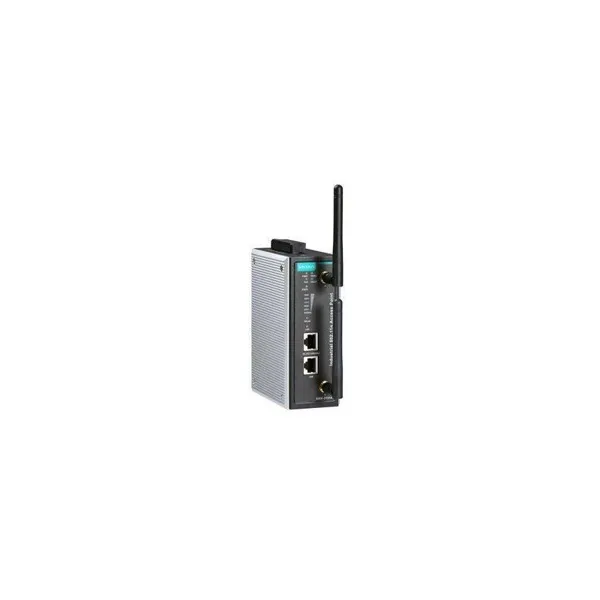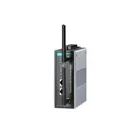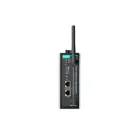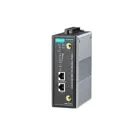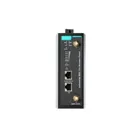AWK-3131A-US - 802.11abgn access point, US band, -25 to 60C operating temperature
Introduction
The AWK-3131A 3-in-1 industrial wireless AP/bridge/client fulfils the growing need for faster data transmission speeds by supporting IEEE 802.11n technology with a net data rate of up to 300 Mbps. The AWK-3131A complies with industry standards and approvals for operating temperature, input voltage, overvoltage, ESD and vibration. The two redundant DC power inputs increase the reliability of the power supply and the AWK-3131A can be powered via PoE to facilitate deployment. The AWK-3131A can operate in both the 2.4 and 5 GHz bands and is backward compatible with existing 802.11a/b/g deployments to future-proof your wireless investments. The wireless add-on for the MXview network management program visualises the AWK's invisible wireless connections to ensure wall-to-wall Wi-Fi connectivity.
Advanced 802.11n Industrial Wireless Solution
802.11a/b/g/n-compatible AP/bridge/client for flexible deployment
Software optimised for long-distance wireless communication with up to 1 km line of sight and external high-gain antenna (only available at 5 GHz)
Supports 60 simultaneously connected clients
DFS channel support enables a wider selection of 5-GHz channels to avoid interference with existing wireless infrastructure
Advanced wireless technology
AeroMag supports error-free setup of basic WLAN settings for your industrial applications
Seamless roaming with client-based turbo roaming for < 150 ms roaming recovery time between APs (client mode)
Supports AeroLink Protection to establish a redundant wireless connection (< 300 ms recovery time) between APs and their clients
Industrial robustness
Integrated antenna and power isolation to protect against external electrical interference with 500 V isolation
Wireless communication in hazardous areas with Class I Div. II and ATEX Zone 2 certifications
-40 to 75°C wide operating temperature models (-T) for smooth wireless communication in harsh environments
Wireless network management with MXview Wireless
Dynamic topology view shows the status of wireless connections and connection changes at a glance
Visual, interactive roaming playback function for checking the roaming history of clients
Detailed device information and performance indicator diagrams for individual AP and client devices
Note: the use of this device is restricted or not permitted in some countries. Please check with the authority responsible for your country.
WLAN interface
- WLAN standards: 802.11a/b/g/n, 802.11i Wireless security
- Modulation type: DSSS, OFDM, MIMO-OFDM
Frequency band for the USA (20 MHz operating channels):
- 2.412 to 2.462 GHz (11 channels)
- 5.180 to 5.240 GHz (4 channels)
- 5.260 to 5.320 GHz (4 channels)
- 5.500 to 5.700 GHz (11 channels)
- 5.745 to 5.825 GHz (5 channels)
Frequency band for EU (20 MHz operating channels):
- 2.412 to 2.472 GHz (13 channels)
- 5.180 to 5.240 GHz (4 channels)
- 5.260 to 5.320 GHz (4 channels)
- 5.500 to 5.700 GHz (11 channels)
Frequency band for JP (20 MHz operating channels):
- 2.412 to 2.484 GHz (14 channels)
- 5.180 to 5.240 GHz (4 channels)
- 5.260 to 5.320 GHz (4 channels)
- 5.500 to 5.700 GHz (11 channels)
- Wireless security: WEP encryption (64-bit and 128-bit), WPA/WPA2-Enterprise (IEEE 802.1X/RADIUS, TKIP, AES), WPA/WPA2-Personal
Transmission rate:
- 802.11b: 1 to 11 Mbps
- 802.11a/g: 6 to 54 Mbps
- 802.11n: 6.5 to 300 Mbps
Transmission power for 802.11a:
- 23±1.5 dBm @ 6 to 24 Mbps
- 21±1.5 dBm @ 36 Mbps
- 20±1.5 dBm @ 48 Mbps
- 18±1.5 dBm @ 54 Mbps
Transmission power for 802.11n (5 GHz):
- 23±1.5 dBm @ MCS0/8 20 MHz
- 18±1.5 dBm @ MCS7/15 20 MHz
- 23±1.5 dBm @ MCS0/8 40 MHz
- 17±1.5 dBm @ MCS7/15 40 MHz
Transmission power for 802.11b:
- 26±1.5 dBm @ 1 Mbps
- 26±1.5 dBm @ 2 Mbps
- 26±1.5 dBm @ 5.5 Mbps
- 25±1.5 dBm @ 11 Mbps
Transmission power for 802.11g:
- 23±1.5 dBm @ 6 to 24 Mbps
- 21±1.5 dBm @ 36 Mbps
- 19±1.5 dBm @ 48 Mbps
- 18±1.5 dBm @ 54 Mbps
Transmission power for 802.11n (2.4 GHz):
- 23±1.5 dBm @ MCS0/8 20 MHz
- 18±1.5 dBm @ MCS7/15 20 MHz
- 23±1.5 dBm @ MCS0/8 40 MHz
- 17±1.5 dBm @ MCS7/15 40 MHz
Reception sensitivity for 802.11a (measured at 5.680 GHz):
- Typ. -90 @ 6 Mbps
- Typ. -88 @ 9 Mbps
- Typ. -88 @ 12 Mbps
- Typ. -85 @ 18 Mbps
- Typ. -81 @ 24 Mbps
- Typ. -78 @ 36 Mbps
- Type. -74 @ 48 Mbps
- Type. -72 @ 54 Mbps
- Note: Due to a limitation in receiver sensitivity performance for channels 153 and 161, it is recommended not to use these channels in your critical applications.
Receiver sensitivity for 802.11n (5 GHz; measured at 5.680 GHz):
- Type. -69 dBm @ MCS7 20 MHz
- Typ. -71 dBm @ MCS15 20 MHz
- Typ. -63 dBm @ MCS7 40 MHz
- Typ. -68 dBm @ MCS15 40 MHz
- Note: Due to a limitation in receiver sensitivity performance for channels 153 and 161, it is recommended not to use these channels in your critical applications.
Receiver sensitivity for 802.11b (measured at 2.437 GHz):
- Type. -93 dBm @ 1 Mbps
- Type. -93 dBm @ 2 Mbps
- Typ. -93 dBm @ 5.5 Mbps
- Typ. -88 dBm @ 11 Mbps
Reception sensitivity for 802.11g (measured at 2.437 GHz):
- Typ. -88 dBm @ 6 Mbps
- Typ. -86 dBm @ 9 Mbps
- Typ. -85 dBm @ 12 Mbps
- Typ. -85 dBm @ 18 Mbps
- Typ. -85 dBm @ 24 Mbps
- Typ. -82 dBm @ 36 Mbps
- Typ. -78 dBm @ 48 Mbps
- Typ. -74 dBm @ 54 Mbps
Reception sensitivity for 802.11n (2.4 GHz; measured at 2.437 GHz):
- Typ. -70 dBm @ MCS7 20 MHz
- Typ. -69 dBm @ MCS15 20 MHz
- Typ. -67 dBm @ MCS7 40 MHz
- Typ. -67 dBm @ MCS15 40 MHz
- WLAN operating mode: Access point, client, client router, master, slave, sniffer
- Antenna: External, 2/2 dBi, omnidirectional
- Antenna connections: 2 RP-SMA sockets
Ethernet interface
Standards:
- IEEE 802.3 for 10BaseT
- IEEE 802.3u for 100BaseT(X)
- IEEE 802.3ab for 1000BaseT(X)
- IEEE 802.3at for PoE
- IEEE 802.1Q for VLAN tagging
- IEEE 802.1X for authentication
- IEEE 802.1D-2004 for Spanning Tree Protocol
- IEEE 802.1w for Rapid Spanning Tree Protocol
- PoE ports (10/100/1000BaseT(X), RJ45 connection): 1
Ethernet software functions
- Management: DHCP server/client, DNS, HTTP, IPv4, LLDP, Proxy ARP, SMTP, SNMPv1/v2c/v3, Syslog, TCP/IP, Telnet, UDP, VLAN, Wireless Search Utility, MXview, MXview Wireless, MXconfig
- Routing: Port forwarding, static route, NAT
- Redundancy protocols: RSTP, STP
- Security: HTTPS/SSL, RADIUS, SSH
- Time management: SNTP client
Firewall
- Filters: ICMP, MAC address, IP protocol, port-based
Serial interface
- Console connection: RS-232, 8-pin RJ45
LED interface
- LED indicators: PWR1, PWR2, PoE, FAULT, STATE, SIGNAL, WLAN, LAN
Input/output interface
- Digital inputs: 2, Max. Input current: 8 mA, +13 to +30 V for state 1, +3 to -30 V for state 0
- Alarm contact channels: Relay output with a current carrying capacity of 1 A @ 24 VDC
- Buttons: Reset button
Physical properties
- Housing: Metal
- IP protection class: IP30
- Dimensions: 52.7 x 135 x 105 mm (2.08 x 5.32 x 4.13 in)
- Weight: 860 g (1.9 lb)
- Mounting: DIN rail mounting, wall mounting (with optional kit)
Performance parameters
- Input current: 0.6 A @ 12 VDC, 0.15 A @ 48 VDC
- Input voltage: 12 to 48 VDC, redundant dual inputs, 48 VDC Power-over-Ethernet
- Power connection: 1 detachable 10-contact terminal block(s)
- Power consumption: 7.2 W (max.)
- Reverse polarity protection: Supports
environmental limits
- Operating temperature: Standard models: -25 to 60°C (-13 to 140°F), Wide Temp. models: -40 to 75°C (-40 to 167°F)
- Storage temperature (including packaging): -40 to 85°C (-40 to 185°F)
- Ambient Relative Humidity: 5 to 95% (non-condensing)
Standards and Certifications
- EMC: EN 61000-6-2/-6-4
- EMI: CISPR 32, FCC Part 15B Class A
EMS:
- IEC 61000-4-2 ESD: Contact: 8 kV; air: 15 kV
- IEC 61000-4-3 RS: 80 MHz to 1 GHz: 3 V/m
- IEC 61000-4-4 EFT: Power: 2 kV; signal: 2 kV
- IEC 61000-4-5 Surge: Power: 2 kV; signal: 1 kV
- IEC 61000-4-6 CS: 3 V
- IEC 61000-4-8 PFMF
- Potentially explosive atmospheres: ATEX, Class I Division 2, IECEx
- Radio: EN 300 328, EN 301 489-1/17, EN 301 893, FCC ID SLE-WAPN008, ANATEL, MIC, NCC, RCM, SRRC, WPC, KC
- Safety: EN 60950-1, UL 60950-1
- Vibration: IEC 60068-2-6
MTBF
- Time: 570,854 hours
- Standards: Telcordia SR332
